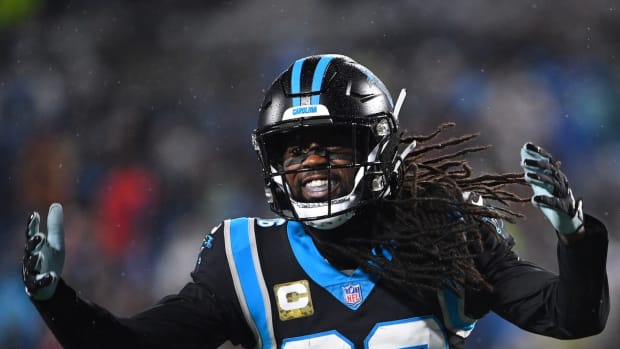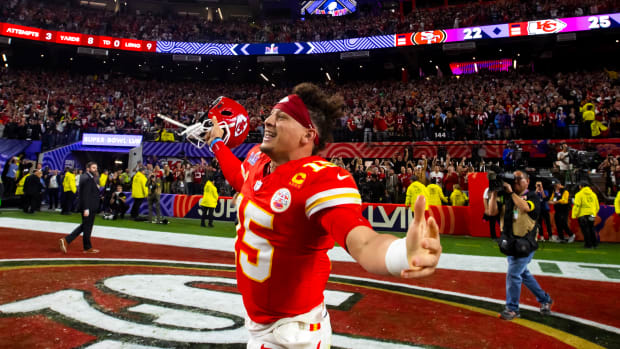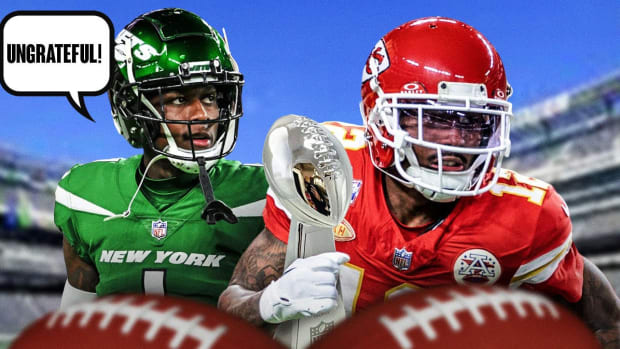Two Years Later, Dak Prescott Has Problems
In 2016, Dak Prescott played under better conditions than any rookie QB in history, if not any QB period. His offensive line was a step beyond dominant, giving the Cowboys a commanding running game and its quarterback routinely clean pockets from which to throw. Defenses were still treating Dez Bryant like a No. 1 receiver, rolling safety help his way. That clarified Prescott's reads, presenting obvious one-on-one throws in other parts of the field. Underneath, Prescott had the ultimate security blanket in tight end Jason Witten, and a mismatch-maker in shifty slot ace Cole Beasley. On top of it all, Prescott was new, so defenses had little film on him. The young QB capitalized on these conditions, posting a 104.9 passer rating and guiding the Cowboys to a 13-3 season.
To outside observers, America’s Team had its franchise QB. But within the NFL, some of the old guard cautioned to pump the brakes. History suggested—nay, guaranteed—that those perfect conditions would not last. Prescott should only be evaluated once his circumstances normalized.
Sure enough, they have. This season, that offensive line has been less imposing without superstar center Travis Frederick, who is out indefinitely while he recovers from Guillain-Barre Syndrome, a disorder that affects the nervous system. Without Frederick, Ezekiel Elliott and the ground game has been, at least by 2016 standards, spotty. Defenses figured out last year that Bryant was washed up; they stopped rolling coverage his way, and so this offseason the Cowboys stopped employing him. He’s now out of football. So is Jason Witten, who retired to fill Jon Gruden’s vacant MNF seat. Beasley is still around, but as anyone with even a smidgen of football acumen suspected, he’s more dynamic as a third or fourth option.
These aren’t dire straits Dallas is in, they’re regular NFL “straits,” which is why the Cowboys’ record since 2016—10-8, including their 1-1 start this year—is almost perfectly average. Quarterbacks get paid to spin gold from “perfectly average.” Head coach Jason Garrett and offensive coordinator Scott Linehan must figure out how to help Prescott do that.
Over the years, Garrett and Linehan have run a simplistic passing attack, featuring spread formations and basic route designs. Prescott, who played in a spread system at Mississippi State, is comfortable here. The problem is, this approach requires receivers who can win in space. Dallas’s current receiving corps resembles a rotation you’d see in the second quarter of a preseason game. Garrett and Linehan learned the hard way in the Week 1 loss at Carolina that a basic passing attack won't work. Guys couldn't get open and Prescott threw with little sense of timing and poor accuracy.
He was much better in Week 2 against the Giants, but it was far from a pristine offensive performance overall. Take out Tavon Austin’s early 64-yard touchdown and the Cowboys had 96 yards passing on 24 dropbacks. On the bright side, their running game got going in the second half, finishing with 138 yards on the night, including 45 from Prescott, who flourished on read-options.
Conceptually, those read-options speak to what the Cowboys must do. Those are highly schemed designs that put defenders in an intellectual bind. That must be the approach Dallas takes with its passing game. To win with average receivers, you must win through design. Replace the spread formations and quasi-isolation routes with pre-snap motion, trips bunches and tight formations, where receivers align close to the ball and run intersecting routes that have enough space to go left or right. And run the ball from some of these looks to propagate misdirection and play-action concepts.
Not only is this the best approach given Prescott’s surroundings, it’s the best approach given Prescott himself. He is a facilitating type of QB. He plays with a high pre-snap IQ, a poised post-snap decision-making process and a good-but-not-great arm, mixed with upper-shelf mobility. If this were basketball, he’d be a point guard who could shoot decently from 22 feet in and control the game with the ball in his hands—like a Rajon Rondo, only with leadership skills.
A highly schemed offense gives a quarterback more defined reads, which will help Prescott play with the decisiveness that he sometimes lacks. An offense doesn’t become highly schemed overnight. Given that these updates would have to be implemented on the fly, the best Dallas can do right now is take some of its basic concepts and employ them out of different formations, creating the illusion of complexity. Getting back to their play-action bootleg game and building more passes off the read-option looks would help. That leverages Prescott’s mobility, which is what defenses fear most. When the defense fears Prescott’s legs, its backside players tend to play cautiously, which can help open an outside zone running game that, even without Frederick, should be snappier than we've seen so far.
This week presents a perfect opportunity to implement changes. The Cowboys are facing a Seahawks defense that has a bevy of struggling rookies, a paucity of pass rushers and a mostly predictable zone-based system. That’s ideal for running highly schemed offensive plays.
This would take some guts from Garrett. There could be short-term growing pains that jeopardize the path to an NFC East title—something Jerry Jones can reasonably believe exists given his team’s ascending defense. But long-term for this season, and certainly for Prescott’s career, the best move is to reshape the offense around its young QB.
If you want the latest episode of The NFL Deep Dive Podcast in your feed when you wake up Thursday morning, then subscribe to The MMQB Podcasts. For non-subscribers, there is typically a lag.
TWEET ELABORATION
The 49ers now have an excellent linebacker combination with Reuben Foster returning from his two-game suspension. Speed and awareness at this position are critical in defensive coordinator Robert Saleh’s predominantly Seahawks style scheme.
PATRICIA VS. THE PATRIOTS
Most coaches will tell you that the hardest thing in football to figure out is an opponent’s protection rules. It’s the one area where the film can consistently mislead and withhold information. I once heard a very reputable offensive coach say to another coach that there’s only one NFL defensive play-caller who truly understands protections. The other coach guessed, “Matt Patricia?” Yes, Matt Patricia.
What’s interesting is that Patricia rarely rushes aggressively. According to Football Outsiders, with the Patriots last year, he blitzed only 21.2% of the time (12th-lowest in the league) and he rushed just three men a league-high 23.7% of the time. He faces New England Sunday night. What will Patricia, master of protection diagnostics, do against the opponent whose protections he’s surely most familiar with?
Or, more interestingly, how will the Lions offense attack the Patriots’ defense? With Bill Belichick still at command, the Pats are running a similar scheme under new de facto coordinator Brian Flores as they did under Patricia. And Patricia is running that same scheme in Detroit. You can bet the first-year head coach has informed his offensive coordinator, Jim Bob Cooter, of the scheme’s weak spots. Future Lions opponents should study this film carefully. How the Lions attack the Patriots D could well reveal how Patricia doesn’t want his own D to be attacked.
DESEAN JACKSON: ALL-TIME DEEP WEAPON
DeSean Jackson’s 75-yard touchdown against the Eagles on Sunday was the 23rd time he has caught a 60-plus-yard touchdown, tying the NFL record. I was surprised to learn that the previous sole record-holder had been Jerry Rice. Yes, it’s probably foolish to not assume Rice, holder of seemingly all records receiving. But I don’t remember him being a mega big-play threat. I would have guessed Randy Moss had the record.
But like many of Rice’s records, this one can be chalked up to his amazing longevity and consistency. He got his 23rd 60-yard touchdown in game 303 of his career (September 29, 2002 as a Raider). Jackson has amassed his 23 long touchdowns over just 142 games. The takeaway? Rice was incredible (you knew that) and Jackson can be considered for the pantheon of football's all-time greatest big-play weapons.
NON-FOOTBALL ITEM ON MY MIND
We need to change the order of how we present buffets. Instead of starting with the small items—salad, fruit, side dishes—start with the main entree. That way you can base your side dish choices around the entree, just like at a restaurant, where you always order the entree and then the sides. Plus, this helps ameliorate the spatial problems we so often encounter at the end of a buffet, where we discover that our aggressiveness on salad and side dishes has left little room for that big slab of meat we want.
• Question or comment? Email us at talkback@themmqb.com.




































